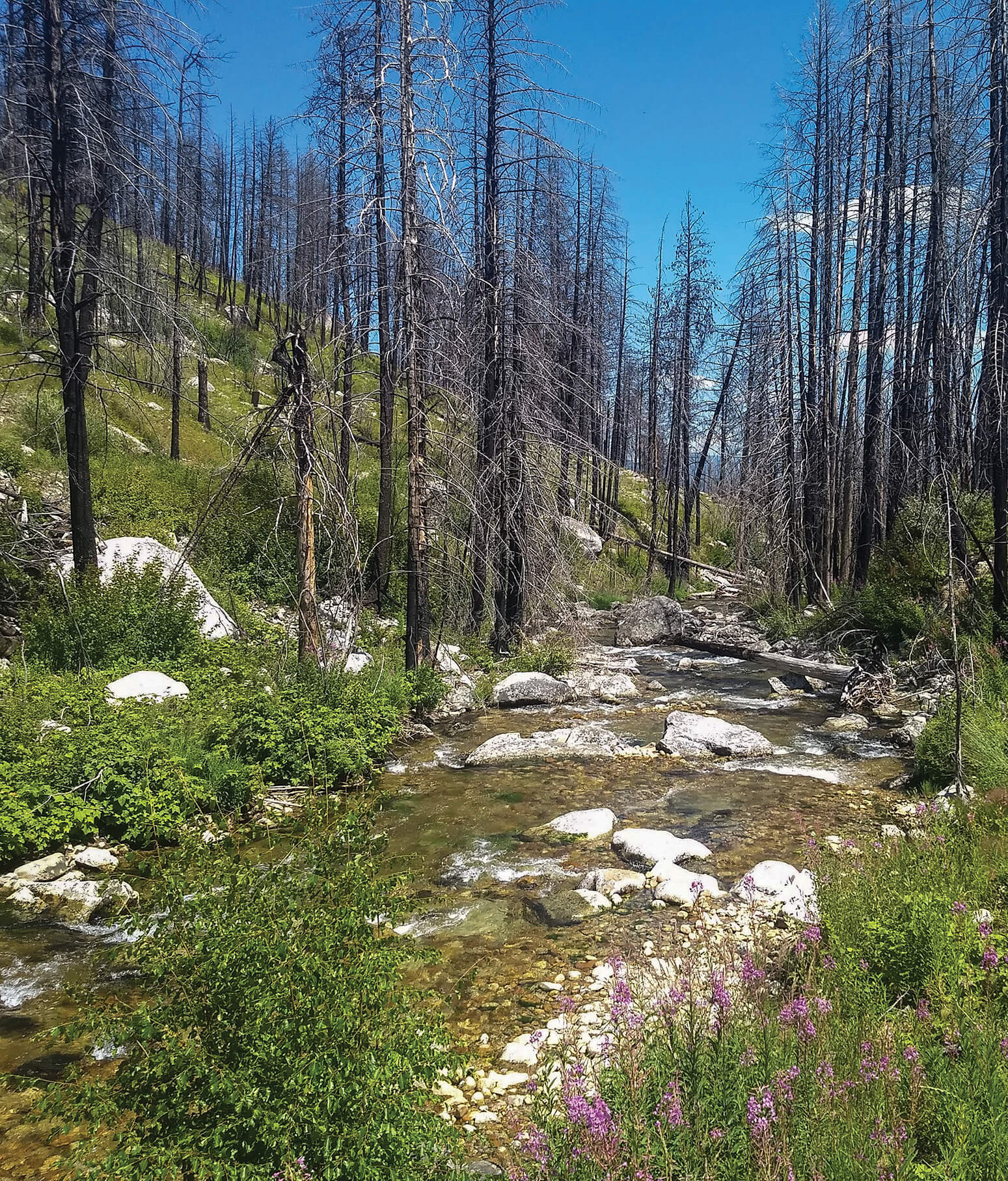
01 Feb A Stream of Life Through a Scarred Land
Some might find it strange that one of my favorite trout streams flows through a burned-over canyon.
I first visited Roaring Lion Creek in mid-July 2019, almost three years after a wildfire engulfed much of its basin. It was a cool and cloudy day, with drizzling rain threatening to become a downpour. But it never did, and so the fishing conditions remained great — not too warm, with no sun beating down to keep the trout from looking up at our dry flies. I had never before fished in a recently burned area, so I took in our surroundings as my brother and I readied our gear and approached the creek. Especially on that dreary day, the pink-purple flowers and vibrant green of renewed vegetative growth sharply contrasted with the charred remains of trees that blanketed the hillsides and bordered the stream. It was visually striking.
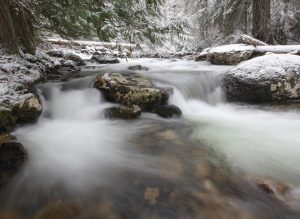
Roaring Lion Creek, shown here before the 2016 wildfire, drains cold, clear water from the granitic Bitterroot Range into the Bitterroot River near Hamilton, Montana. The stream supports the full array of salmonids found in the Bitterroot basin: brook trout, brown trout, bull trout, mountain whitefish, rainbow trout, and westslope cutthroat trout. Photo by PATRICK CHAPLIN
Measuring nearly 15 miles long, Roaring Lion Creek drains water from western Montana’s towering Bitterroot Range into the Bitterroot River just south of Hamilton. I wrote in my fishing journal that the creek was “a stream of life through a scarred land.” There was indeed life in that water; in the short time I spent plying the reach near the Sawtooth Creek trailhead, I caught a few small cutthroat, a 7-inch brookie, and a 10-inch brown — all on dry flies. I love fishing small streams, and Roaring Lion’s setting captivated me. Many might not find charm in a fire-ravaged canyon, but I found it inspiring to fish in a place that had recently been through hell but was clearly bouncing back. And it didn’t hurt that there seemed to be plenty of trout there eager to take a fly.
Within a few hours, a wildfire that began near Roaring Lion Creek on July 31, 2016, consumed over 3,500 acres of timberland. By the time it ended weeks later, it had engulfed over 8,500 acres, destroyed 16 homes and dozens of other structures, and cost approximately $10.5 million to suppress. The U.S. Forest Service had planned a 2,300-acre fuel reduction project in the area, but a campfire beat the agency to the punch. Several teenagers later faced felony and misdemeanor charges of negligent arson after they admitted to starting the campfire that investigators identified as the wildfire’s source. Timber salvage efforts that began in early 2017 at trailheads near the creek removed massive ponderosa pines that were over a century old when Lewis and Clark trekked down the Bitterroot in 1805. Forest Service personnel expressed optimism that the canyon would recover naturally because of the timing of the fire and the abundance of viable pine cones in the area.
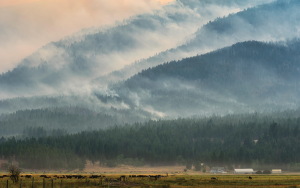
In July 2016, Roaring Lion joined the growing list of Montana watersheds that experienced a major wildfire since 2000 as a blaze erupted that consumed over 3,500 acres in its first few hours and over 8,500 acres in total. Photo by ZACK CLOTHIER
Although the intensity of the Roaring Lion blow-up was stunning — a video available on YouTube shows how quickly a faint wisp of smoke became a sky-darkening inferno — it was but one of many wildfires that ravaged the Bitterroot in recent decades. The summer of 2000 inaugurated an age of more frequent, intense, and large fires fueled by climate change and past forest management practices. That year, approximately 356,000 acres of land burned in the Bitterroot basin. The first decade of the new millennium became the first to see more than 100,000 acres burned in the Bitterroot National Forest since 1910 – 1919 (the decade of the legendary Big Burn). Large fires occurred periodically after the Big Burn, but the Sleeping Child wildfire of 1962 was the last big one before those of 2000 devastated the upper Bitterroot, in particular. Fires have since become commonplace in the drainage, with Roaring Lion but one of a growing number of wildfires that have raged during the annual fire season.
Such wildfires can affect trout fisheries, as well. In the Bitterroot, fish mortality followed the 2000 fires as heavy rains that hammered burned-over portions of several drainages caused landslides, debris flows, and sediment pulses. In the long term, fires can alter nutrient and chemical dynamics, channel structure, aquatic-habitat complexity, and water-temperature regimes. Some effects — such as increased summer stream temperatures resulting from the loss of riparian vegetation — may harm cold-water fish populations, while others — such as the enhancement of instream habitat complexity through additions of large woody debris — can benefit them. Studies conducted in the upper Bitterroot after the wildfires of 2000 found that maximum summer water temperatures in stream reaches that had burned at high intensity remained elevated several years later, which could make them unsuitable for species like bull trout that require especially cold water.
The extent to which wildfires affect trout fisheries largely depends upon how much human activities altered local aquatic habitat conditions and how healthy fish populations were before a fire occurred. It appears that trout streams featuring robust local and neighboring fish populations, intact migratory corridors, and high-quality instream habitat are more resilient to the effects of even severe wildfires. Findings in the Bitterroot, moreover, suggest that native westslope cutthroat and bull trout are more resilient to wildfire impacts than nonnative brook trout; the former evolved in a region in which fire was a regular natural disturbance, while the latter did not. Some research, however, indicates that the long-term water temperature increases that sometimes follow wildfires may enable nonnative brown trout — which prefer warmer waters than do cutthroats and bulls — to colonize headwater streams. The impact of fire on trout streams is, in short, highly variable and localized. Still, it is generally not the death knell for fisheries that one might assume.
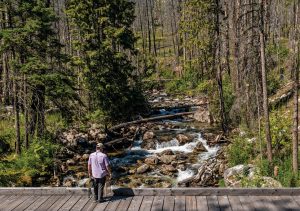
Despite Roaring Lion Canyon’s recent trauma, it still supports excellent recreational opportunities, especially for anglers and hikers. Photo by JESSICA HAYDAHL RICHARDSON
My experience at Roaring Lion Creek suggests that trout streams can indeed thrive after a fire. I revisited that creek just four days after my first trip. This time, a bright, sunny day offered a different — although equally impressive — perspective of the canyon as I explored more of the creek, both up and downstream of the footbridge near the Sawtooth Creek trailhead.
The variety that Roaring Lion offers adds to its appeal. Below the bridge, it races through a steep, narrow ravine that largely requires an angler to boulder hop within its channel. Above the bridge, the stream meanders and occasionally braids through a meadowy area that the inferno opened up; it is navigable despite some deadfall. My short afternoon trip yielded a half-dozen brookies — the largest, an 8-inch beauty — and 10 cutthroats that took dry flies, mainly mayfly patterns.
When I next returned in late July 2021, I noted that the canyon had further recovered during my two-year absence. It was even greener and the riparian vegetation, especially, appeared more robust. I landed a pair of brookies and a cutthroat that day, but what I particularly recall was the haze of smoke that drifted over the Bitterroots from fires that then raged in Idaho. That stark reminder of Roaring Lion’s turbulent recent past made me appreciate the place even more.
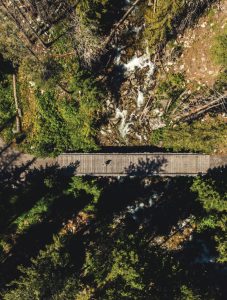
Wildfires can benefit trout fisheries by adding large woody debris to streams, enhancing aquatic habitat complexity and providing fish with cover. As this recent photo illustrates, the 2016 wildfire added such structure to Roaring Lion Creek. Photo by JESSICA HAYDAHL RICHARDSON
My next visit to the creek, on a cool, rainy, and windy early August day a week later, proved equally memorable. Between casts, I glanced at the sky up the canyon as a wall of rain approached. The growing wind — which could topple the still-standing dead trees that line the creek — nearly forced me to leave. But the storm strayed north along the ridge that marks the drainage’s boundary and the wind calmed, allowing me to land a brook trout and six cutts before departing.
Although the closing of the season showed when I next visited in late September 2022 — the green to which I was accustomed had largely browned beyond the creek’s edges — the canyon’s ongoing revitalization was nevertheless evident. And, while the streamflow was the lowest I have seen there, the creek was as alive as ever. In a visit that stretched from late morning to late afternoon, I covered far more of the creek than before, working downstream from the footbridge near the Sawtooth Creek trailhead before heading well upstream into the meadowy reach. The fish didn’t mind looking up on one of the Bitterroot’s final summery days of the year, as the air temperature reached into the 80s and the sun blazed through a cloudless sky. I went through many flies as the fish kept drowning patterns that included several Micro-Chubby Chernobyl color combinations and multiple mayfly variations. All in all, my grand total included 39 cutthroats, five browns, and, as I scrawled in my journal, a dozen “of the most beautiful brookies I have ever caught.”
Stream surveys conducted by Montana Fish, Wildlife & Parks (MT FWP) at Roaring Lion Creek before the 2016 fire found the full range of salmonids that inhabit the Bitterroot basin: bull trout, mountain whitefish, westslope cutthroat, brook trout, browns, and rainbow trout. Montana’s surviving stocking records for the creek document just a few cutthroat plantings since 1930. The nonnative browns, brookies, and rainbows were therefore either introduced earlier or migrated there after being stocked elsewhere. Fisheries biologists haven’t sampled Roaring Lion’s fish population since 2012, so the distribution and abundance of individual species may have changed since the fire. I have, for example, never caught a rainbow or bull trout there, but I have only fished parts of the creek; survey data indicates that bull trout, for instance, reside further upstream. Regardless, there remains plenty of fish to catch.
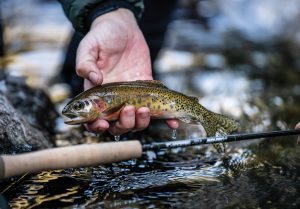
Studies conducted in the Bitterroot since the intense fire season of 2000 indicate that native salmonids such as cutthroat trout are more resilient to wildfire impacts than the nonnative species, such as Eastern brook trout, that often compete with them. Photo by JESSICA HAYDAHL RICHARDSON
The appeal of Roaring Lion Creek extends beyond its distinctive appearance and gullible fish. With the 2016 blowup occurring only about 4 air miles from Hamilton, the canyon is eminently accessible. When I visit family in the area, it’s about a 20-minute drive to the trailhead and then a short walk to the stream. And yet, there is a measure of solitude to be found there. The only fishing pressure estimate that MT FWP has completed for Roaring Lion indicated that fishermen spent a mere 369 angler days there in 2013. That paltry figure has likely not increased since fire ravaged the drainage. Although the trailheads attract a few hikers, I have personally never seen another soul fishing that stream aside from my company.
I last visited Roaring Lion in mid-June 2023. Although it ran clear, the stream was high, as peak flows from snowmelt had not yet fully receded and the spring months had been especially rainy. Lush green foliage and abundant wildflowers attested to the season and the canyon’s ongoing rebirth; pine saplings dotted the landscape, and the brush along the creek was more dense. Cooler weather convinced my dad — who usually avoided the creek because there wasn’t “a stick of shade” to provide refuge from the sun — to fish with me there twice. The first time, we went further upstream, near the Roaring Lion trailhead, which features lots of boulders and deadfall. It resembles the section downstream of the footbridge near the Sawtooth Creek trailhead but is not quite as steep and rugged. A few small cutthroats hammered the Micro-Chubby Chernobyl that I dropped into small runs along logs on that sunny morning.
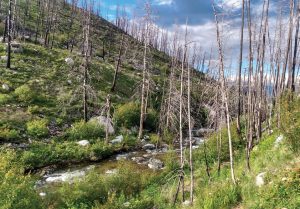
Charred, dead pines stand as monuments to the 2016 wildfire, even as the lush green of renewed vegetative growth highlights the area’s recovery in this June 2023 photo taken near the Sawtooth Creek trailhead. Photo by ADAM R. HODGE
When we returned two days later, a wall of rain visible up the canyon kept us near the Sawtooth Trail. The fish largely ignored my dry flies on that overcast evening, so I tied up a dry-dropper rig consisting of a Micro-Chubby and a stonefly nymph. I was instantly rewarded for not quite being a “dry or die” angler when an 11-inch brown took the nymph on my first cast into a pool downstream of the footbridge. That stonefly imitation landed me two smaller cutthroats just above the bridge before the daily thunderstorm arrived and forced us to leave.
And so, quite a bit of life remains in Roaring Lion Creek after a wildfire swept its canyon in 2016. The same undoubtedly holds true for many other Montana streams that have burned over in recent years. Personally, I have found that fishing in an overlooked place that offers ample reminders of both its trauma and its resilience can make one more deeply appreciate the experience.
Adam R. Hodge is a history professor who earned his doctorate at the University of Nebraska. He is currently working on a book that examines the history of bull trout in Montana’s Bitterroot basin and another that considers the arctic grayling’s past, present, and future in the Treasure State.




No Comments